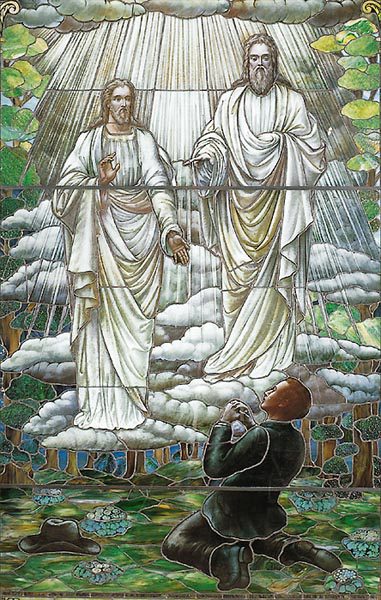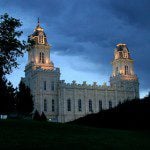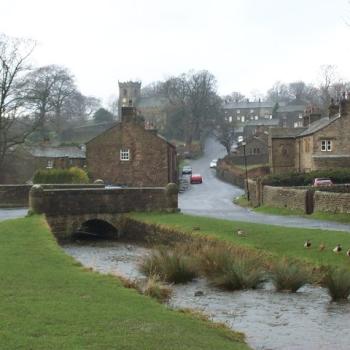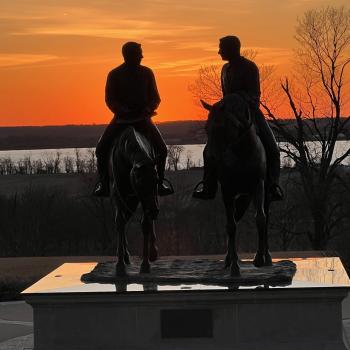
A 1913 stained glass by an unknown artist
(Wikimedia Commons public domain image)
***
A new article — this one by Loren Blake Spendlove — went up two or three hours ago in Interpreter: A Journal of Latter-day Saint Faith and Scholarship:
“The Word of the Lord as a Metonym for Christ”
Abstract: The word of the Lord and the word of God are common expressions in the Bible. Frequently, these phrases refer to the written or spoken covenantal words of God to his people as given through the prophets. However, exegetical study of these expressions has revealed that they also serve as metonyms, or substitutions for the name of God himself. In this paper I explore these metonymous usages of the Word of the Lord and the Word of God as stand-ins for Christ in the Bible and in the Book of Mormon.
***
Which reminds me: Some other articles have already been published in Interpreter. Here are links to five of them:
Loren Blake Spendlove, “Discipleship As the World Collapses Around You”
Review of Adam S. Miller, Mormon: A Brief Theological Introduction (Provo, UT: The Neal A. Maxwell Institute for Religious Scholarship, 2020). 162 pages. $9.95 (paperback).
Abstract: Adam Miller has created a thoughtful and enlightening theological study of the book of Mormon. It is obvious from his textual commentary that Miller has given a significant amount of thought and effort into teasing out practical insights from the book’s original authors. Except for some clumsy distractions that occasionally appear in his text, I would highly recommend Miller’s analysis of Mormon’s and Moroni’s apocalyptic narratives.
S. Kent Brown, “Jesus’ First Visit to the Temple”
Abstract: In this rich and detailed description, S. Kent Brown paints an evocative, historically contextualized account of Jesus Christ’s first visit to the Jerusalem Temple since his infancy, when at age twelve he traveled with his family to attend Passover.
[Editor’s Note: Part of our book chapter reprint series, this article is reprinted here as a service to the Latter-day Saint community. Original pagination and page numbers have necessarily changed, otherwise the reprint has the same content as the original.
See S. Kent Brown, “Jesus’ First Visit to the Temple,” in The Temple: Symbols, Sermons, and Settings, Proceedings of the Fourth Interpreter Foundation Matthew B. Brown Memorial Conference, 10 November 2018, ed. Stephen D. Ricks and Jeffrey M. Bradshaw (Orem, UT: The Interpreter Foundation; Salt Lake City: Eborn Books, 2021), 235–66. Further information at https://interpreterfoundation.org/books/the-temple-symbols-sermons-and-settings/.]
Brian C. Hales, “Seeking a Global Context for the First Vision”
Review of Richard E. Bennett, 1820: Dawning of the Restoration (Provo, UT: Religious Studies Center at Brigham Young University / Salt Lake City: Deseret Book, 2020). 380 pages. Hardcover, $31.99.
Abstract: Richard E. Bennett’s latest volume, 1820: Dawning of the Restoration, is not a book about the First Vision. Instead, it describes the world in 1820 through thirteen biographies that provide useful context to the seminal event. Included are Napoleon Bonaparte, Jean Francois Champollion, Alexander I, Ludwig van Beethoven, Theodore Gericault, Samuel Taylor Coleridge, George IV/Queen Caroline, John Wesley/William Wilberforce/Hannah More, Simon Bolivar, John Williams, Henry Clay, Alexander Von Humboldt, and Joseph Smith. Topics of military conquest, music, science, literature, art, linguistics, religion, politics, and the industrial revolution receive extensive coverage for 1820 and the surrounding decades. Even if readers are not seeking an expanded understanding of the world that launched the Restoration, this well-written and highly researched compilation would be an interesting and rewarding read.
Craig L. Foster, “Understanding the Year 1820”
Book Note: Richard E. Bennett, 1820: Dawning of the Restoration (Provo, UT: Religious Studies Center at Brigham Young University / Salt Lake City: Deseret Book, 2020). 380 pages. Hardcover, $31.99.
Abstract: Richard E. Bennett’s 1820: Dawning of the Restoration takes a look at this significant year in a global historical context. He has produced a fascinating book for both members of the Church and non-members.
Stephen D. Ricks, “Psalm 105: Chiasmus, Credo, Covenant, and Temple”
Abstract: In this essay Stephen Ricks takes a close look at the literary structure of a psalm, reintroducing us to chiasmus both in modern and ancient texts, including the Book of Mormon, then uses this literary structure to show how the psalm contains the basic historic credo of the Israelites, as seen in Deuteronomy and mirrored in 1 Nephi 17. Ricks then goes on to show how an essential part of the psalm is a covenant (“a binding agreement between man and God, with sanctions in the event of the violation of the agreement”), which ties it back to the temple. Ricks shows this by pointing out the points of covenant: Preamble, review of God’s relations with Israel, terms of the covenant, formal witnesses, blessings and curses, and reciting the covenant and depositing the text. This form is maintained in Exodus 19, 20, 23, and 24, and in the Book of Mormon in Mosiah 1-6. Psalm 105 follows this form, too. In the sacrament prayers, which in Mormon understanding is a covenant, points 1 to 5 are also present.
[Editor’s Note: Part of our book chapter reprint series, this article is reprinted here as a service to the LDS community. Original pagination and page numbers have necessarily changed, otherwise the reprint has the same content as the original.
See Stephen D. Ricks, “Psalm 105: Chiasmus, Credo, Covenant, and Temple,” in Temple Insights: Proceedings of the Interpreter Matthew B. Brown Memorial Conference, “The Temple on Mount Zion,” 22 September 2012, ed. William J. Hamblin and David Rolph Seely (Orem, UT: The Interpreter Foundation; Salt Lake City: Eborn Books, 2014), 157–170. Further information at https://interpreterfoundation.org/books/temple-insights/.]
***
I know. I know. I’ve let all of you down who eagerly crave regular evidence of the evils of religious belief and the damage that is done to society by religious organizations. I’ll try to do better at this Bah Humbug Holiday Season. The opportunities should be plentiful, because this is a time of the year when religious people and religious groups go out of their way to try to give the season a religious spin and to exploit it for their shameless theological agendas. Here, for example, are a couple of items that I’ve just discovered in the Christopher Hitchens Memorial “How Religion Poisons Everything” File© and that, I hope, will give you a delicious thrill of horror and righteous indignation:
“Donors will #LightTheWorld in largest single-event blood drive in Florida history”












